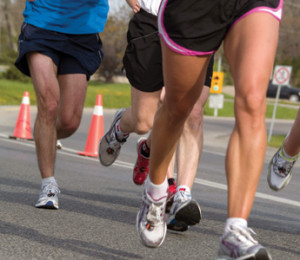
istockphoto.com 6128073
PFPS responds to exercise
Intervention improves pain, function
Two recently published studies add to the body of medical literature supporting exercise as therapy for patellofemoral pain.
A randomized controlled trial from the Netherlands suggests that a multi-faceted exercise program is more effective than “usual care” for improving pain and function in patients with patellofemoral pain. And, although most exercise-based intervention studies have focused on strength and neuromuscular variables, another study from Ireland offers support for hamstring stretching exercises in particular.
Researchers from Erasmus University in Rotterdam randomized 131 patients with new episodes of patellofemoral pain syndrome to an intervention group or a control group. Patients in the control group received “usual care” from their physicians, including verbal and written information about patellofemoral pain, recommendations to avoid activities that provoke pain, and general instructions for daily isometric quadriceps contractions to be performed at home. Those in the intervention group participated in an exercise program for six weeks under a physical therapist’s supervision, then were instructed to continue the exercises for another three months at home.
The exercise program involved 25 minutes per session and included static and dynamic strengthening of the quadriceps, hip adductor, and gluteal muscles, balance training, and flexibility exercises for major thigh muscles. During the supervised portion of the intervention, patients visited the therapist twice a week for three weeks, then once a week for another three weeks. Exercise intensity and/or number of repetitions were increased every two weeks during this time. Thereafter, patients were instructed to continue the exercises at home for 25 minutes per day.
Changes from baseline for self-reported pain at rest, pain during activity, and function were all significantly greater in the exercise group than in the control group, both at three-month and one-year follow-up testing. The percentage of patients reporting that they had “fully recovered” or “strongly recovered,” according to the Likert scale, improved in both groups over time but did not differ significantly between groups at either follow-up point. However, when the recovery measure was expanded to include “slightly recovered,” recovery at three months was significantly more likely in the intervention group than the controls (81% vs 53%).
The Dutch findings, which were e-published on October 20 by the British Medical Journal, appear to be consistent with those of an earlier randomized controlled trial from the University of Melbourne in which multi-modal physical therapy was significantly more effective than placebo treatment for improving pain and disability. In the Australian study, published in the November-December 2002 issue of the American Journal of Sports Medicine, the six-week intervention program included quadriceps retraining using biofeedback, patellofemoral joint mobilization, and home exercises as well as patellofemoral taping.
Thigh muscle flexibility was on ly one component of the Dutch exercise intervention, but research from Dublin City University suggests that exercises to lengthen the hamstrings specifically may be key to reducing stress on the patellofemoral joint during loading activities such as squatting.
Irish investigators analyzed 16 healthy subjects, eight of whom had reduced hamstring length. As the subjects performed squats, patellofemoral joint contact area was determined using magnetic resonance imaging and patellofemoral joint reaction force determined using motion analysis. A biomechanical model was then used to calculate stress on the joint.
They found that subjects with shorter hamstrings experienced significantly greater total stress and lateral stress on the patellofemoral joint at 60º of knee flexion, during both the ascent and descent phases of squatting. Joint reaction force was significantly higher and medial joint contact area was significantly smaller at the same knee flexion angle in the subjects with reduced hamstring length.
The findings were e-published on October 7 by Gait & Posture.
Biomechanical analysis finds telltale toes, Achilles moment arms set sprinters apart
According to research from Pennsylvania State University, one can recognize a sprinter by the length of his toes. Or the plantar flexion moment arms of his Achilles tendons, though that’s probably more difficult to eyeball.
Penn State investigators compared structural foot and ankle characteristics in 12 collegiate sprinters with those of 12 non-athletes who were matched for height. Compared to the non-athletes, sprinters’ Achilles tendon moment arms were 25% shorter on average. In addition, the sprinters had significantly longer toes, shorter lower legs, longer lateral gastrocnemius fascicles, and a larger ratio of fascicle length to moment arm.
A biomechanical computer simulation then showed that shorter plantar flexion moment arms and longer toes were the two variables that contributed most to optimum generation of forward impulse. The findings were published in the November issue of the Journal of Experimental Biology.
The authors theorized that shorter moment arms slow muscle shortening, enabling greater force production. Longer toes increase the time in which the foot is in contact with the ground, allowing muscles extra time to generate acceleration force.
Soccer study links hamstring injury to older age, power, lost flexibility
Older soccer players whose legs are more powerful than flexible face a higher risk of hamstring injury than their fellow players, according to a prospective study of English Premier League athletes.
Researchers from the University of Teesside in Middlesbrough, United Kingdom, analyzed 36 elite male professional soccer players during pre-season training and then followed them for the length of a 45-week competitive season.
They found that the odds of a hamstring injury increased with age (1.78 greater odds for each year older), non-countermovement jump performance (1.47 for each cm in jump height), and active range of hip flexion (1.29 for each lost degree of ROM).
The findings, which were e-published on October 1 by the Journal of Science and Medicine in Sport, are consistent with those of a previous study of hamstring injuries in Australian football players. The earlier study followed 126 players for one season and found that higher relative risk of injury was associated with older age and lesser quadriceps flexibility. Those results were published in the February 2005 issue of the British Journal of Sports Medicine.









